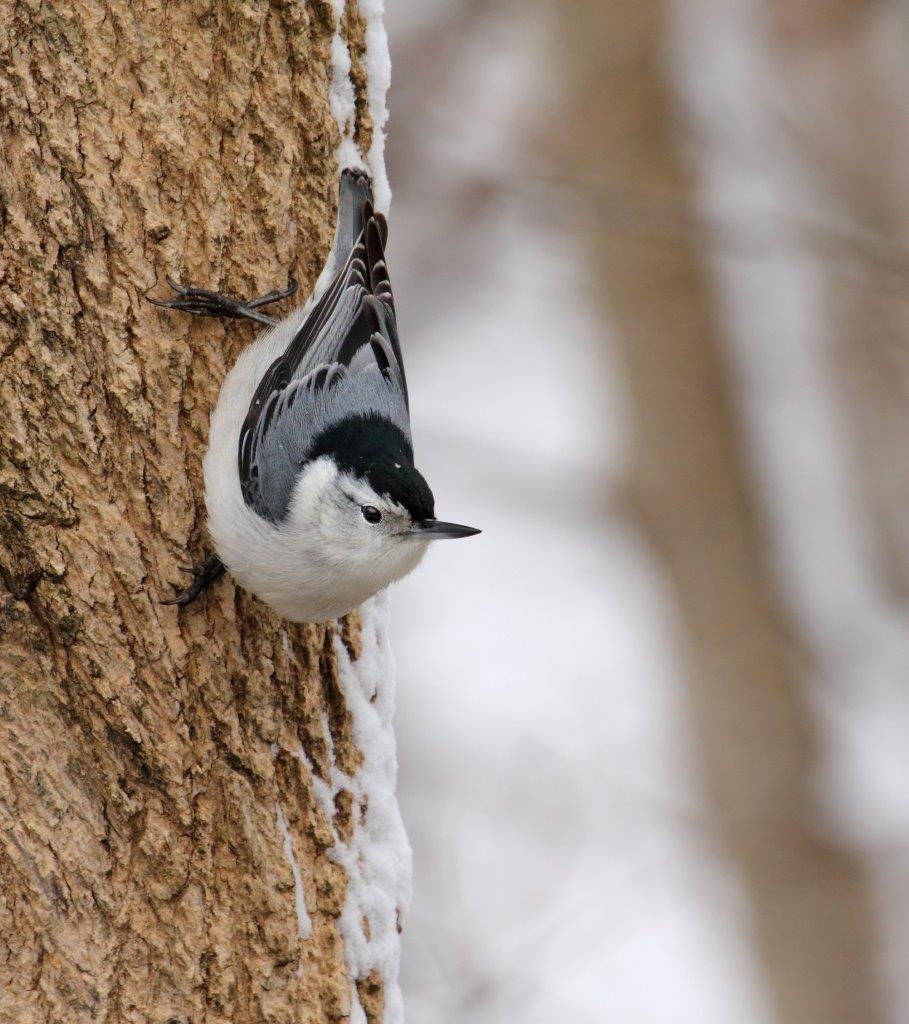In winter, tree trunks provide both food and shelter to wildlife
- Tags:
- Wildlife

A white-breasted nuthatch often seen spiraling downward on tree trunks where it caches food in bark furrows. Photo Charles Brutlag, Dreamstime
On bitter-cold January nights, water trapped beneath tree bark expands and freezes with an audible “pop!” Sub-zero temperatures rupture tiny tubes comprising the “xylem” layer which is arranged like bundles of microscopic drinking straws, the innermost ring of tubes in the sapwood. That audible pop of freeze-cracking is a cruel sound of a mid-winter’s night in a frozen forest.
While the trees stand stoically against the cold, they provide a cozy refuge – critical winter habitat for the insects, birds and mammals best adapted to life in northern forests.
Each tree species has distinctive bark designed to protect tender sapwood from attack by insects, fungi and injuries. Bark color, texture and thickness plays an important role in tree adaptation to winter freeze and thaw cycles.
The bark of young saplings and pole-sized trees is smooth and tight. The craggy, deeply-furrowed bark of old trees provides a more fully-stocked insect pantry. As trees expand outward, their once-clear log faces develop characteristic fine lines and wrinkles (to say nothing of crow’s feet) that deepen to form distinctive ridges, deep furrows or shaggy plates quite unlike the boles of younger trees of the same species. You can make your own analogies.
With the addition of mosses and lichens over time, the wide variety of bark characteristics provides both food and shelter essential to winter wildlife survival. Beneath loose plates of bark lies a hidden world of hibernating fireflies, spiders, beetles, ants and moths. Inside cocoons, pupae rest in suspended animation while inside tiny frozen eggs, developing larvae await the warming pulse of spring.
Birds and small mammals expertly probe beneath tree bark, gleaning tasty, protein-rich and fat-rich insects. English muffins are no match for the myriad "nooks and crannies" packed with nutritious overwintering insects in every acre of mature New Hampshire forest. Resident winter birds including chickadees, white-breasted and red-breasted nuthatches, tufted titmice, blue jays, gray jays and both downy and hairy woodpeckers spend the better part of every winter day probing bark to glean insects, eggs or bits of lichen.
In autumn, the same birds along with mice also cache tiny wind-blown seeds of birch and aspen and larger maple seeds, beechnuts and even oak acorns in bark crevices above the snow. A treasury of calorie-rich, black oil sunflower seeds, millet seeds and thistle seeds from local birdfeeders is hoarded and transported to restock the hidden tree bark larder against the prospect of leaner days or empty feeders.
But tree trunks emerging from deep snow also provide a different kind of winter food pantry and shelter for small mammals. When the sun’s rays strengthen in February and March, south-facing sides of trees warm up daily, melting snow away from the bark to create “melt-wells.” These little moats catch blowing bits of birch or conifer seeds and tumbleweeds of tiny dislodged lichens and reveal exposed green patches of moss or ferns. Mouse, vole and squirrel tracks in the snow link to the food supplies in melt wells and connect beneath the snow to their relative shelter. The small mammals on the open snowpack are pitilessly exposed as if scurrying across a white tablecloth set for hungry owls or prowling coyotes.
The next time you walk in winter woods, pay attention to mammal tracks leading to melt wells and look closely at birds probing loose bark. You will likely discover that trees’ protective bark is better than winter’s cruelest bite!
